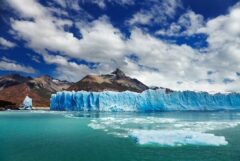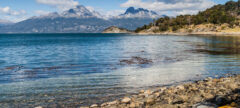Private Journeys
Luxury Chile and Argentina: Simply Patagonia
13 days from £10,900pp
(based on two people sharing & excluding flights)
Essentials
-
Tour info
-
Country info
-
What's included
Tour info
Transport
3 flights (longest 3.5hrs); 3 scenic road journeys.
Accommodation
This holiday offers first class accommodation in fine locations throughout – from boutique-style properties in Santiago and the lake district to some of the best upcountry lodges in southern Patagonia with staggering views, and the renowned Park Hyatt in Buenos Aires.
Meals
Breakfast daily, lunch day 2, full board days 3-8, dinner days 9, 10 and 12.
Guides
We carefully select our local partners, some of whom we have worked with for over 25 years. Their English-speaking guides understand the expectations of our clients very well, and are consistently singled out for praise by the latter on their return.
Summary Of Nights
13 days, 12 nights: Santiago 2; Torres del Paine 4; El Calafate 2; Lake District 2; Buenos Aires 2
How To Take It
Cash machines are available in all major cities and towns, and so taking a debit or credit card with a PIN number is the most convenient way of withdrawing money while on your trip, and in most shops and restaurants you can also pay by card. However, ATMs can be temperamental and you should not rely exclusively on a card to access funds. We recommend that additionally you take a reasonable quantity of US dollars cash (no more than is covered by your insurance), which you can exchange into local currency. Dollar bills should be in good condition, soiled or torn bills may be refused. You can take sterling, but the exchange rate is not always competitive or even available, restricting the number of places where you can change money.
For our latest currency advice for Argentina please see our FAQs section.
Currency
The unit of currency in Chile is the Chilean peso; Argentina has the Argentine peso.
Daily Spend
Some meals are already included in the cost of your stay. For additional expenses but a budget of around US$35-50 per person per day should cover the cost of meals not included in the holiday itinerary, drinks and the odd souvenir.
Tipping
Tips are expected and local guides often rely on their tip as a significant proportion of their income.
Most service industry workers will expect a tip of some kind and so it is useful to have spare change for hotel porters, taxi drivers and the like. It is common to leave 10 – 12% in restaurants.
Insurance
Travel insurance is essential.
Details of our recommended policy can be found on our Travel Insurance page.
Trip Suitability
In Torres del Paine National Park all walks are optional. Hikes vary in length (between 2 and 8 hours) and difficulty (most are easily followed and relatively flat). Riding and biking is suitable for fit beginners. If you find time to walk in the lake district, trails are undulating but not strenuous.
Be prepared for some early mornings, and for extreme weather conditions in the south.
Climate
Winter in the Southern Hemisphere is between May and September. In Santiago and Buenos Aires, temperatures can be cool (5°C – to 15°C). While sunshine is possible, so is rain. Spring temperatures, October to November and March to April are between 15 and 25°C and there is a good deal of pleasant sunshine. January and February are hot, around 30°C.
The lake district has weather not dissimilar to our own, but a bit sunnier in summer and rather rainier in the winter months.
The weather in the far south is notoriously unpredictable throughout the year. During the southern hemisphere summer (October to March) there can be blizzards or heat waves. The adage “four seasons in a day” is very apt here. In winter days are short and snow is not uncommon but it is rarely much below freezing, because of the moderating influence of the sea.
Clothing And Special Equipment
A day pack is essential for carrying rainwear, snacks, books and a water bottle. Outside summer, those who feel the cold might take thermals. To ensure your comfort while walking in Patagonia, you should bring a good waterproof, walking boots (tried and tested so you don’t get blisters!) as well as a good waterproof top, trousers and a warm hat and a scarf.
That said the sun in summer can be strong so take a hat with a visor, sunglasses and sun block. Some walkers find hiking poles helpful and binoculars are useful for bird spotting.
Please get in touch with the office before departure if you have any doubts. Good equipment is very important and hard to come by in South America.
Vaccinations
Preventative vaccinations are recommended against the following: polio; tetanus; hepatitis A. You should consult your GP for specific requirements.
You can also find helpful information on the Masta Travel Health website.
Visas
Holders of a full British passport do not require a visa, although passports must be valid for at least 6 months after the trip begins. Anyone with a different nationality should enquire with us or check with the relevant consulate.
If flying to the US, or via the US you will need to fill in your online ESTA application.
Airport Taxes
If you have purchased your flights through Journey Latin America, the international departure tax is usually included in the ticket.
Country info
When is the best time to visit Chile?
Chile is a year-round destination. The southern hemisphere's seasons are the reverse of Europe’s, with December-February as mid-summer. Spring (October-November) and autumn (March-April) can be pleasant and quieter, while winter (June-August) is coldest. The lake district, Santiago and Valparaiso have warm, sunny summers, while in Patagonia weather is more unpredictable. The Atacama Desert has extremes of heat and cold, while Easter Island has pleasant temperatures all year, warmest October-March, cooler June-September.
For more detailed information visit our When To Go section.
What is the official language of Chile?
The official language of Chile is Spanish.
How do I get local currency in Chile?
The local currency in Chile is the Chilean Peso. Notes can be withdrawn from the many ATMs in larger towns and cities using a UK credit or debit card. Limits may be lower than your UK bank allows. There are also many banks and money exchanges (casas de cambio) where you can exchange US dollars cash; rates for euros and sterling are harder to find and frequently poor. Non-resident foreign guests at hotels in Chile do not normally pay the 19% VAT on most extras (such as food and drink consumed on the premises) if the bill is settled in US$ (cash or credit card) upon checking out.
What's the time difference between Chile and UK?
The time difference between the UK and Chile is GMT -4 hours. Sometimes daylight saving is observed in the summer, from Sep/Oct to early Mar.
What countries combine well with Chile?
Bolivia, accessing the south of country from San Pedro de Atacama, travelling via salt lakes of the Salar de Uyuni; Argentina, crossing the Andes over one of several scenic passes: from the Atacama Desert in the north to Salta, from Santiago to Mendoza, via the lakes crossing from Puerto Varas to Bariloche in the lake district and from Torres del Paine to El Calafate in Patagonia.
Do I need a visa to visit Chile?
Holders of a full British passport do not require a visa, although passports must be valid for at least 6 months after the trip begins. Anyone with a different nationality should enquire with us or check with the relevant consulate.
If flying to the US, or via the US you will need to fill in your online ESTA application.
What vaccinations do I need for Chile?
Please check Travel Health Pro for information on health recommendations and vaccinations for the destinations you are visiting. Please note that many Latin American countries require proof of vaccination against Yellow Fever if you have recently travelled to another country where Yellow Fever is present.
What are the festivals, cultural and sport events in Chile?
Tapati festival, Easter Island is normally during the first 2 weeks of February with traditional music, dance and sports.
On New Years Eve Valparaiso has an impressive firework display.
What do I need to know about altitude in Chile?
Whilst a typical holiday in Patagonia presents no challenges with altitude, parts of northern Chile (Lauca National Park and parts of the Atacama Desert) offer a spectacular introduction to the high Andes, with several attractions at over 3,000m. Travel to high altitude can cause mountain sickness and even if you feel fighting fit it’s important to take things easy and stay hydrated (drink plenty of water, avoiding alcohol and caffeine) as you get used to the thin, dry air. You may initially notice a headache, dizziness or breathlessness and this usually improves with acclimatisation. If you are pregnant or taking the contraceptive pill, have a medical condition such as heart or lung condition, anaemia, asthma, high blood pressure you should seek the advice of your GP before booking. We also recommend you check your travel insurance covers travel to high altitude. If you’re taking the family, remember small children may be less capable of communicating altitude-related symptoms effectively: keep an eye on them too. Rest assured we will plan your itinerary carefully, taking into account any time spent at altitude. If you have any questions or concerns about altitude please speak to your travel expert.
Further advice on travel to altitude is available on www.travelhealthpro.org.uk.
When is the best time to visit Argentina?
Argentina is so large it’s always a good time to go somewhere. The southern hemisphere summer is the reverse of our own, with Dec-Feb being high summer in Patagonia. Spring (Oct-Nov) and Autumn (Mar-Apr) can still be very pleasant and are quieter. While summers in the lake district are reliably warm and sunny, the further south in Patagonia you go the more unpredictable the weather. In Winter (June-Sept) some hotels in Patagonia close, while others stay open for skiers. Buenos Aires, Mendoza and Córdoba enjoy a Mediterranean-type climate, with cool winters and very warm summers. North-west Argentina (Salta and Jujuy) enjoy sunshine and warm temperatures year-round but are influenced by altitude and the high Andes, with occasional cold snaps (June-Sept) and a rainy season (Jan-Feb). Iguazú Falls and Misiones has a subtropical climate, although it can be chilly July-Sept.
For more detailed information visit our When To Go section.
What is the official language of Argentina?
The official language of Argentina is Spanish.
What is Argentina's official currency?
The official currency of Argentina is the Argentine Peso.
Although cards have become more widely accepted, cash remains useful in Argentina so don’t rely solely on your cards. Taking funds in a mix of formats (a supply of US$ cash to convert into Pesos locally, along with your cards) is a sensible plan. In Buenos Aires and main tourist hubs you should have few problems paying by card but in more remote areas often only cash is accepted. You’ll also need cash for tips (eg if you pay for a restaurant meal with a card, tips are always left in cash). When changing money, denominations of US$50 and US$100 are usually preferred and you should make sure your notes are in perfect condition. Although ATMs are available, local ATM fees are high and the amount you can take out is lower than in the UK. We tend to avoid them.
We think it’s a good idea to keep an eye on Argentina’s exchange rates before you go. In addition to the official (BNA) rate of exchange for converting your US Dollars to Pesos, Argentina also uses a parallel exchange rate for foreign tourists (MEP). This is about 15% better than the official rate. Some casas de cambio will automatically apply the better tourist rate when changing your money. Others will only apply the official (BNA) rate. Rates used to process credit/debit card transactions can vary between card issuers, but you should find you get something between the official and tourist rates. Check your statement.
Try not to end up with a lot of leftover Pesos at the end of your time in Argentina, as it is difficult to change them to other currencies. You should be able to spend them at the Duty Free shop at Buenos Aires airport.
Please note that given the changeable situation with the Argentine economy, currency matters can change at short notice.
What's the time difference between Argentina and UK?
The time difference between Argentina and UK is GMT -3 hrs. Sometimes daylight saving is observed in the summer, from Sep/Oct to early Mar, but not every year.
Do I need a visa for Argentina?
Holders of a full British passport do not require a visa, although passports must be valid for at least 6 months after the trip begins. Anyone with a different nationality should enquire with us or check with the relevant consulate.
If flying to the US, or via the US you will need to fill in your online ESTA application.
What vaccinations do I need for Argentina?
Please check Travel Health Pro for information on health recommendations and vaccinations for the destinations you are visiting. Please note that many Latin American countries require proof of vaccination against Yellow Fever if you have recently travelled to another country where Yellow Fever is present.
Which other countries combine well with Argentina?
Chile, accessing the country by crossing the Andes over one of several scenic passes: from Salta in the northwest to the Atacama Desert, from Mendoza to Santiago, via the lakes crossing from Bariloche to Puerto Varas in the lake district and from El Calafate to Torres del Paine in Patagonia; Brazil, via the land crossing at Iguazú.
What are the festivals and other cultural or sporting events in Argentina?
• Tango Festival: Buenos Aires, August.
• Polo Open: Buenos Aires province, weekends in November.
• Gaucho Festivals: The pampas, early November.
How do I adapt to the altitude in Argentina?
Whilst a typical holiday in Patagonia presents no challenges with altitude, Argentina’s north-western provinces offer a taste of the high Andes with some spectacular road trips on offer. Travel to high altitude can cause mountain sickness and even if you feel fighting fit it’s important to take things easy and stay hydrated (drink plenty of water, avoiding alcohol and caffeine) as you get used to the thin, dry air. You may initially notice a headache, dizziness or breathlessness and this usually improves with acclimatisation. If you are pregnant or taking the contraceptive pill, have a medical condition such as heart or lung condition, anaemia, asthma, high blood pressure you should seek the advice of your GP before booking. We also recommend you check your travel insurance covers travel to high altitude. If you’re taking the family, remember small children may be less capable of communicating altitude-related symptoms effectively: keep an eye on them too. Rest assured we will plan your itinerary carefully, taking into account any time spent at altitude. If you have any questions or concerns about altitude please speak to your travel expert.
Further advice on travel to altitude is available on www.travelhealthpro.org.uk
Inspired by this trip
Our exciting range of articles on Latin America explore everything from iconic destinations and lesser-known cultural gems to delicious traditional recipes. You’ll also find exclusive travel tips, first-hand client reviews and the chance to get your personal questions answered by our travel experts.
Papagaio
Your edit for Latin American inspiration
Our exciting range of articles on Latin America explore everything from iconic destinations and lesser-known cultural gems to delicious traditional recipes. You’ll also find exclusive travel tips, first-hand client reviews and the chance to get your personal questions answered by our travel experts.
View Extraordinary Inspiration







































